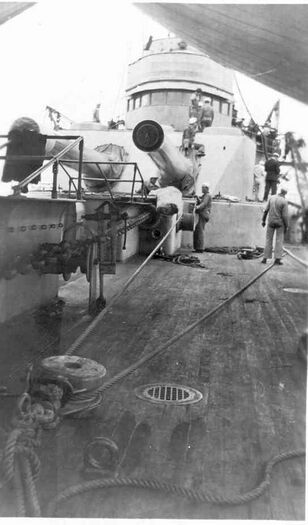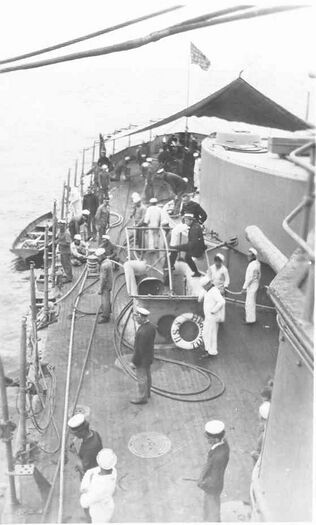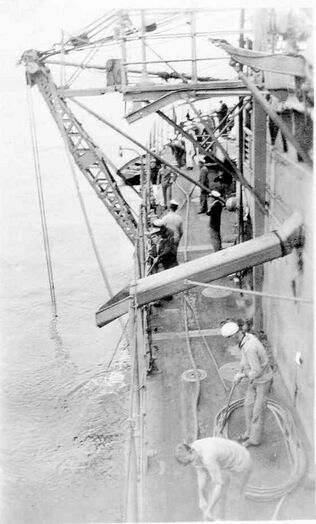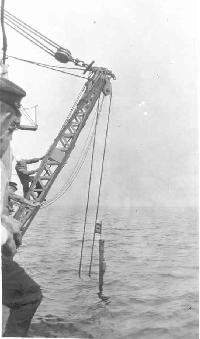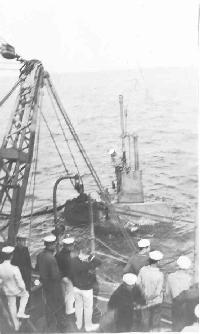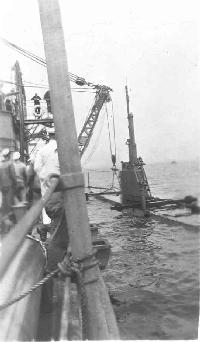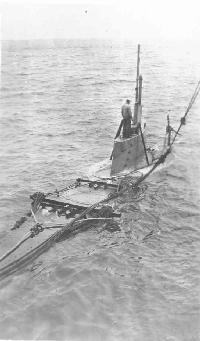General C-class photos: Difference between revisions
Pbcjohnston (talk | contribs) Added captions |
Pbcjohnston (talk | contribs) Added new Header |
||
| (10 intermediate revisions by 2 users not shown) | |||
| Line 1: | Line 1: | ||
[[File:C- | [[File:New Header C-class.jpg]] | ||
[[File:C-class boat.jpg|left|500px]] | [[File:C-class boat.jpg|left|500px]] | ||
<div style="text-align: justify;"><span style="color:#00008B">An unidentified C class submarine, date unknown. The sub maybe in transit to Guantanamo Bay, Cuba or Panama. We believe she is making an extended surface run. Note the small boat tied to the starboard side of the fairwater. She would not dive with this boat lashed up like that. Secondly, notice the square "trunk" just aft of the bridge | <div style="text-align: justify;"><span style="color:#00008B">An unidentified C class submarine, date unknown. The sub maybe in transit to Guantanamo Bay, Cuba or Panama. We believe she is making an extended surface run. Note the small boat tied to the starboard side of the fairwater. She would not dive with this boat lashed up like that. Secondly, notice the square "trunk" just aft of the bridge. It must be temporary in nature and was rigged to allow the aft hatch to be opened for access topside during an extended surface run. Having that hatch open during a run in anything but glass calm seas would inevitably lead to flooding through the hatch, thus the trunk was rigged to keep the waves out. It would also allow better air flow to the engines, providing a different path for air flow instead of down the conning tower hatch. | ||
<small>Photo in the private collection of Ric Hedman.</small> | <small>Photo in the private collection of Ric Hedman.</small> | ||
| Line 9: | Line 9: | ||
[[File:C-class in Norfolk drydock.jpg|left|500px]] | [[File:C-class in Norfolk drydock.jpg|left|500px]] | ||
Five C-boats and the tender USS Severn together in drydock at the Norfolk Navy Yard, Portsmouth, VA., February 11, 1911. The submarines are, left to right and back to front are the Stingray, Salmon, Bonita, Tarpon, and Snapper. Portions of the aft superstructure have been removed over the engine mufflers. This could be a class wide refit of the engine exhaust systems. | Five C-boats and the tender [https://www.navsource.org/archives/09/86/86003.htm '''USS Severn'''] together in drydock at the Norfolk Navy Yard, Portsmouth, VA., February 11, 1911. The submarines are, left to right and back to front are the Stingray, Salmon, Bonita, Tarpon, and Snapper. Portions of the aft superstructure have been removed over the engine mufflers. This could be a class wide refit of the engine exhaust systems. | ||
<small>Photo in the private collection of Ric Hedman.</small> | <small>Photo in the private collection of Ric Hedman.</small> | ||
| Line 16: | Line 16: | ||
[[File:C-class in Norfolk drydock 2.jpg|left|500px]] | [[File:C-class in Norfolk drydock 2.jpg|left|500px]] | ||
Another view of the above photo taken February 11, 1911. Seen left to right, front to back are; Salmon, Bonita, Stingray, (back) Snapper, Tarpon. The submarine tender | Another view of the above photo taken February 11, 1911. Seen left to right, front to back are; Salmon, Bonita, Stingray, (back) Snapper, Tarpon. The submarine tender Severn is in the back of the dock. Note the different shape of the bow of the Bonita. | ||
Just why the bow caps of these submarines are painted a light color is unknown. One theory could be they have been painted with zinc chromate as an anti-corrosion coating before being painted with regular hull colors. The yellow of the zinc chromate would show up as white in black and white photography. | Just why the bow caps of these submarines are painted a light color is unknown. One theory could be they have been painted with zinc chromate as an anti-corrosion coating before being painted with regular hull colors. The yellow of the zinc chromate would show up as white in black and white photography. | ||
| Line 34: | Line 34: | ||
Four C-class submarines moored to the port side of the USS Severn. These subs are speculated to be Tarpon, Octopus, Bonita and Stingray based on a photo from another angle. The time frame is circa pre-November 1911. Location is possibly New York Harbor. | Four C-class submarines moored to the port side of the USS Severn. These subs are speculated to be Tarpon, Octopus, Bonita and Stingray based on a photo from another angle. The time frame is circa pre-November 1911. Location is possibly New York Harbor. | ||
Two of the four submarines have dory type skiffs pulled up on their fore decks for transport to shore. There is a Severn crewman in the lifeboat leaning out and looking at the cameraman as the photo is taken. There are three men on deck on the left hand sub plus one on the bridge. On the third sub from the left there is a man on the bridge and a man has climbed down a ladder on the side of the Severn and is stepping onto the pressure hull of the inboard boat. Two of the boats have their engines started. | Two of the four submarines have dory type skiffs pulled up on their fore decks for transport to shore. There is a Severn crewman in the lifeboat leaning out and looking at the cameraman as the photo is taken. There are three men on deck on the left hand sub plus one on the bridge. On the third sub from the left there is a man on the bridge and a man has climbed down a ladder on the side of the Severn and is stepping onto the pressure hull of the inboard boat. Two of the boats have their engines started. All of the boats have a rounded tent-like covering on the starboard side of the bridge. This is a temporary enclosure for the officer of the deck and the Quartermaster to keep the navigation charts and equipment topside without them blowing away in the wind. | ||
<small>U.S. Navy photo</small> | <small>U.S. Navy photo</small> | ||
[[File:Red bar sub.jpg]] | |||
[[File:C-class with USS Dixie.jpg|left|500px]] | |||
An unidentified C-class submarine, approximately 1912-1913. The location is not known for sure, but we are speculating that it is Guantanamo Bay, Cuba during fleet exercises. She is anchored in the midst of other Atlantic Fleet units. The crew of the sub has done laundry and has clothing and bedding topside for drying and airing out. The ship in the right background is the destroyer tender [https://www.navsource.org/archives/09/03/0301.htm '''USS Dixie (AD-1)''']. In the left background is likely a [https://destroyerhistory.org/early/bainbridgeclass/ '''Bainbridge-class destroyer''']. | |||
<small>Photo in the private collection of Ric Hedman.</small> | |||
[[File:Red bar sub.jpg]] | [[File:Red bar sub.jpg]] | ||
[[File:C-class canal color.jpg|left|500px]] | [[File:C-class canal color.jpg|left|500px]] | ||
A post card | A post card that shows a picture taken shortly after the one on the previous page (March 9, 1914), but this time taken from atop the closed Gatun Lock gate. Pumping down of the lock has started and the boats are noticeably lower than before. The lock was to be used as a makeshift drydock. Since the canal was not yet fully open, this could be allowed. After the opening of the canal, an operation like this would not be allowed since it would effectively close the canal. | ||
<small>Photo in the private collection of Ric Hedman.</small> | <small>Photo in the private collection of Ric Hedman.</small> | ||
[[File:Red bar sub.jpg]] | |||
[[File:C in middle E chamber Mar 9-1914.jpg|left|500px]] | |||
<div style="text-align: justify;"><span style="color:#00008B"> A closeup of the original photo that made the postcard above. All five of the C-Class submarines are seen together in the middle east chamber of the Gatun locks on March 9, 1914, prior to the official opening of the Panama Canal. The Panama Canal was officially opened on August 25, 1914. The submarines are entering the locks to use them as an impromptu dry dock. | |||
The Submarines are left to right the C-4, C-5, C-2, C-3 and C-1. The Submarine Division designator numbers are on their conning tower fairwaters as a "1" over another number, (this indicating their physical position in a division at-sea steaming formation). The C-1 is 1 over 3; the C-3 is 1 over 5; the C-2 is 1 over 1 (flagship); C-5 is 1 over 4, and the C-4 is 1 over 2. | |||
Seen on the conning tower of the C-5 (second from left) in the white broad brimmed hat is probably the civilian pilot, whose responsibility it was to guide the submarines through the canal. The is still done to this day. | |||
<small>National Archives photo.</small> | |||
[[File:Red bar sub.jpg]] | [[File:Red bar sub.jpg]] | ||
[[File:C-class in canal lock 2.jpg|left|500px]] | [[File:C-class in canal lock 2.jpg|left|500px]] | ||
All five of the C-class submarines stationed at Panama are seen entering the East High Chamber of the Gatun Locks of the Panama Canal. There were no other dry docking arrangements to be had in Panama at this time. | |||
The Gatun Locks raised vessels a total of 85 feet to the level of the Gatun Lake in three separate "chambers", the Low, Middle and High Chambers. Each chamber had several lock doors that only allowed the needed size of the lock to be raised or lowered rather than taking the time to fill or empty the whole lock. | |||
The time frame for these photos is circa March/April 1914. This photo was used in an April 2, 1914 issue of the Christian Science Monitor newspaper story about the event. The submarines were rafted together and towed by hand, by the combined crews, into the lock and as interior lock doors were passed they were closed until the submarines were in the smallest portion, 400 feet long. No Lock traffic was impeded as the locks had not officially opened for business. The locks officially opened in July 1914. | |||
<small>Photo in the collection of MMCM(SS) Rick Larson, USN (Ret.)</small> | |||
[[File:Red bar sub.jpg]] | [[File:Red bar sub.jpg]] | ||
[[File:C-class dry in canal lock.jpg|left|500px]] | [[File:C-class dry in canal lock.jpg|left|500px]] | ||
As the lock emptied, the rafted boats sat down on wooden cradles that had been pre-placed in the lock chamber. This view shows nearly all of the water out of the chamber and the boats sitting on their cradles and braced to the side walls. Note that the handwritten notation on the photo is in error as to the location of the event. | |||
<small>Photo in the collection of MMCM(SS) Rick Larson, USN (Ret.)</small> | |||
[[File:Red bar sub.jpg]] | [[File:Red bar sub.jpg]] | ||
[[File:C-class dry in canal lock 2.jpg|left|500px]] | [[File:C-class dry in canal lock 2.jpg|left|500px]] | ||
A view from the lock floor with sailors milling about conducting work. The two boats on the left have their bow caps rotated so that the two torpedo tubes are open. Only four of the boats are visible, C-1 is off to the left and out of view. For the remainder (left to right) are the C-2, C-3, C-5, and C-4. | |||
<small>Photo in the collection of MMCM(SS) Rick Larson, USN (Ret.)</small> | |||
[[File:Red bar sub.jpg]] | [[File:Red bar sub.jpg]] | ||
[[File:C-class in canal lock.jpg|left|500px]] | [[File:C-class in canal lock.jpg|left|500px]] | ||
This photo shows three C-class submarines in the third or inner lock of the three Gatun Locks. We know the location because of the presence of the tall thin lighthouse at the inner door between the second and third locks. This lighthouse still stands today and can be seen by all that pass through the canal. This view then means that the vessels are traveling into the canal and Gatun Lake. | |||
Everything looks very new. The locks were officially opened on August 25, 1914 and the five C-boats were officially sent to Panama to scout Panamanian ports and harbors for suitability for U.S. submarines on December 7, 1913. They were redesignated First Division and escorted by four surface ships. Their destination was Cristobal, C.Z. on the Atlantic side of the canal. | |||
The five C-class boats were accompanied by four surface ships, but the record fails to say what kinds of vessels these were. The four masted cargo ship in the rear could be part of the four. That would make this a very early passage through the canal. | |||
It is entirely possible that these submarines may be some of the first vessels through the canal. They were at Cristobal for eight months prior to the "official" opening. They may well have made trial transits prior to the date open to the public. | |||
There are about 100, more or less, people standing at the lock wall watching the little boats go through. A number of Navy men with their wives are present and I suspect civilian workers who are running or supervising the canal are there too. A number are on the other side of the lock. | |||
<small>Photo in the private collection of Ric Hedman.</small> | |||
[[File:Red bar sub.jpg]] | |||
[[File:C-class three boats and DD Panama.jpg|left|500px]] | |||
Three C-class submarines moored to a pier in what is likely Cristobal, Canal Zone, 1913-1917. Moored across the pier is a [https://destroyerhistory.org/early/hopkinsclass/ '''Hopkins-class destroyer''']. | |||
<small>Photo in the private collection of Ric Hedman.</small> | |||
[[File:Red bar sub.jpg]] | [[File:Red bar sub.jpg]] | ||
[[File:C-class control room.jpg|left|500px]] | [[File:C-class control room.jpg|left|500px]] | ||
The view is looking aft in the control room of an unidentified C-class submarine. The panel arrangement shows a higher level of refinement to the construction. The view shows the access ladder leading up from the starboard side and into the conning tower where the fixed periscope and helm were. Between the two panels is the open engine room. On the right side a large vise is attached to a small suspended work bench. Below that is the electric motor for the trim and bilge pump. | |||
In the upper left of the photo what looks like a circular hatch is, what we believe to be, a mounting for a Fessenden Oscillator. This can be seen mounted in a similar photo on the C-1 page. | |||
<small>Photo in the private collection of Ric Hedman.</small> | |||
[[File:Red bar sub.jpg]] | [[File:Red bar sub.jpg]] | ||
[[File:A-boat interior.jpg|left|500px|Interior of an C-Class submarine]] | |||
Interior view of a C-class submarine looking aft into the engine room. The photographer was standing just aft of the electrical control panel seen in the photo above. This is looking down the center line of the submarine with engines to each side. What is assumed to be large power cables are running in the overhead. | |||
<small>Original Photo in the Private Collection of Ric Hedman</small> | |||
[[File:Red bar sub.jpg]] | |||
[[File:C-class New York 1.jpg|left|500px]] | [[File:C-class New York 1.jpg|left|500px]] | ||
October 30, 1912, New York City. The submarines C-5 and C-2 are moored to the west end of the 135th street pier on Manhattan Island. The submarine tender Severn, seen rear right, is moored to the same pier on the north side. | |||
Crowds of people stand on the pier to get glimpses of these strange new underwater craft. In the background, (left), anchored in the Hudson River, is the [http://www.navsource.org/archives/01/16a.htm '''New Jersey (Battleship No. 16)'''] and, center is the [http://www.navsource.org/archives/01/15a.htm '''Georgia (Battleship No. 15)''']. This is probably the 1912 Presidential Review. | |||
On the left hand submarine the name "Snapper" can be read rather easily on the life ring. On the right hand submarine the beginnings of the name "Stingray" can be seen on the life ring. This is an anachronism because the boats had been officially renamed C-5 and C-2 on November 17, 1911. The fact that the life rings still retained the original names is unusual. | |||
<small>Library of Congress photo, Bain Collection.</small> | |||
[[File:Red bar sub.jpg]] | [[File:Red bar sub.jpg]] | ||
[[File:C-class new york 2.jpg|left|500px]] | [[File:C-class new york 2.jpg|left|500px]] | ||
This photo was taken a little bit after the one above. Some work had been conducted on the C-2's aft deck. Lines have been moved around. Note the Allied Signal Bells on the aft deck of both boats. Disregard what is typed on the photo, the photographer was obviously unaware that the two boats had been renamed. | |||
<small>Photo in the collection of MMCM(SS) Rick Larson, USN (Ret.)</small> | |||
[[File:Red bar sub.jpg]] | [[File:Red bar sub.jpg]] | ||
[[File:C-class new york 3.jpg|left|500px]] | [[File:C-class new york 3.jpg|left|500px]] | ||
Another view of the C-5 and C-2. This was possibly taken several days before or after the previous photos. The photographer for this photo has climbed the foremast rigging on the tender Severn. Perhaps he was a crew member assigned to the Severn. | |||
The 3 over 2 seen on the C-5's conning tower fairwater correspond to other known photos. The numbers refer to Submarine Division 3 and the lower number to the vessels place with in the Division. The inboard submarine displays a Division 3 number but the lower number can not be seen. | |||
The boats have drawn quite a crowd on this day. In 1912 very few people had ever seen a submarine. The technology was new and futuristic and the presence of boats in any port always drew throngs of interested people. | |||
<small>Photo in the private collection of Ric Hedman.</small> | |||
[[File:Red bar sub.jpg]] | [[File:Red bar sub.jpg]] | ||
[[File:C-class unknown crew.jpg|left|500px]] | [[File:C-class unknown crew.jpg|left|500px]] | ||
A crew portrait of an unknown C-class boat, circa 1910-1912. The C-class had a crew complement of 15, and 15 men are topside. This is the whole crew. | |||
<small>Photo in the private collection of Ric Hedman.</small> | |||
[[File:Red bar sub.jpg]] | [[File:Red bar sub.jpg]] | ||
[[File:C-class unknown with severn.jpg|left|500px]] | [[File:C-class unknown with severn.jpg|left|500px]] | ||
USS Severn with an unidentified C-class submarine alongside. The location is unknown but suspected to be Panama circa 1914. Built in 1898-1900 as a sheathed, wooden hull bark with auxiliary steam power, Severn was never officially rated as a submarine tender. She was pressed into the role because as a cruiser she was already obsolete when commissioned, a product of a bygone era. | |||
<small>Photo in the private collection of Ric Hedman.</small> | |||
[[File:Red bar sub.jpg]] | [[File:Red bar sub.jpg]] | ||
[[File:C-class unknown with triangle.jpg|left|500px]] | [[File:C-class unknown with triangle.jpg|left|500px]] | ||
An unidentified C-class boat, location and date unknown. The meaning of the white triangle on the fairwater is also a mystery. Geometric shapes were used much later on the R-class boats as a visual identification expedient, but the exact purpose of this triangle is not known. Note the small "fish" flag affixed to the top of the #2 periscope. This is meant to alert any boater who may come upon to sticks floating vertical in the water that there is a submarine below. | |||
<small>Photo in the private collection of Ric Hedman.</small> | |||
[[File:Red bar sub.jpg]] | [[File:Red bar sub.jpg]] | ||
<gallery> | <center> | ||
<gallery mode="packed" widths="250px" heights="350px"> | |||
File:C-class lift 1.jpg | File:C-class lift 1.jpg | ||
File:C-class lift 1A.jpg | File:C-class lift 1A.jpg | ||
| Line 103: | Line 192: | ||
File:C-class lift 10.jpg | File:C-class lift 10.jpg | ||
</gallery> | </gallery> | ||
</center> | |||
<div style="text-align: justify;"><span style="color:#00008B">This 10 photo sequence shows the monitor [http://www.navsource.org/archives/01/nevada.htm '''USS Tonopah (Monitor No. 9)'''], acting as a submarine tender, conducting a training exercise in lifting a "sunken" submarine. The exact date is unknown, but is suspected to be in the wake of the loss of the [[Notable Submarine Accidents|'''F-4 (Submarine No. 23)''']] in 1915. Understandably, the Navy suddenly got very interested in the ability to quickly raise a sunken boat after that disaster, and this exercise was probably meant to explore different methods. They are using a C-class boat for the exercise, but her identity remains unknown. | |||
<small>Photos in the private collection of Ric Hedman.</small> | |||
[[File:Red bar sub.jpg]] | [[File:Red bar sub.jpg]] | ||
Latest revision as of 03:13, 14 March 2025

Photo in the private collection of Ric Hedman.
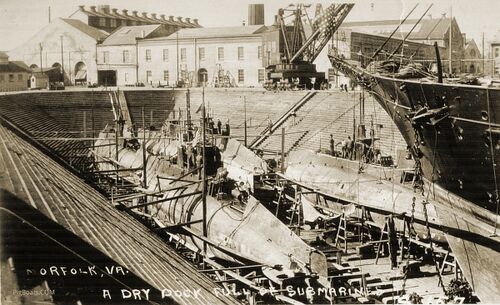
Five C-boats and the tender USS Severn together in drydock at the Norfolk Navy Yard, Portsmouth, VA., February 11, 1911. The submarines are, left to right and back to front are the Stingray, Salmon, Bonita, Tarpon, and Snapper. Portions of the aft superstructure have been removed over the engine mufflers. This could be a class wide refit of the engine exhaust systems.
Photo in the private collection of Ric Hedman.

Another view of the above photo taken February 11, 1911. Seen left to right, front to back are; Salmon, Bonita, Stingray, (back) Snapper, Tarpon. The submarine tender Severn is in the back of the dock. Note the different shape of the bow of the Bonita.
Just why the bow caps of these submarines are painted a light color is unknown. One theory could be they have been painted with zinc chromate as an anti-corrosion coating before being painted with regular hull colors. The yellow of the zinc chromate would show up as white in black and white photography.
Photo in the private collection of Ric Hedman.
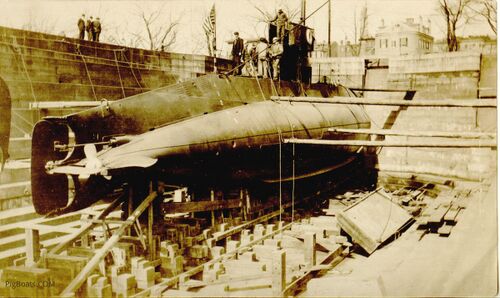
A C-class submarine in drydock at an unknown location, possibly Norfolk or Portsmouth, 1909-1911. The boat is sitting on keel blocks, but the timbers on each side ensure the boat stays upright in the drydock.
Photo in the private collection of Ric Hedman.
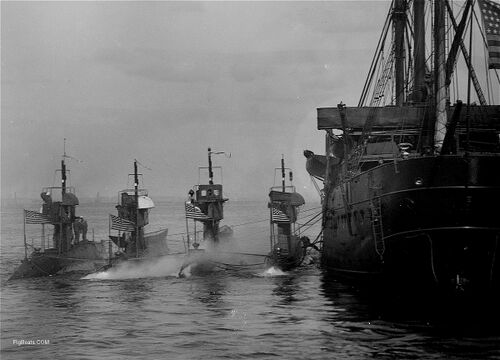
Four C-class submarines moored to the port side of the USS Severn. These subs are speculated to be Tarpon, Octopus, Bonita and Stingray based on a photo from another angle. The time frame is circa pre-November 1911. Location is possibly New York Harbor.
Two of the four submarines have dory type skiffs pulled up on their fore decks for transport to shore. There is a Severn crewman in the lifeboat leaning out and looking at the cameraman as the photo is taken. There are three men on deck on the left hand sub plus one on the bridge. On the third sub from the left there is a man on the bridge and a man has climbed down a ladder on the side of the Severn and is stepping onto the pressure hull of the inboard boat. Two of the boats have their engines started. All of the boats have a rounded tent-like covering on the starboard side of the bridge. This is a temporary enclosure for the officer of the deck and the Quartermaster to keep the navigation charts and equipment topside without them blowing away in the wind.
U.S. Navy photo
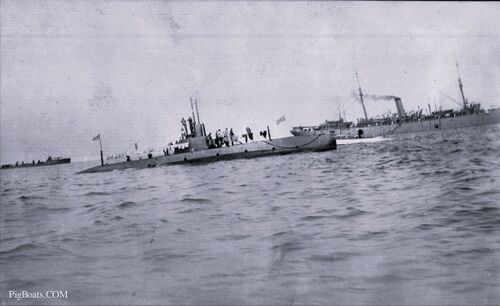
An unidentified C-class submarine, approximately 1912-1913. The location is not known for sure, but we are speculating that it is Guantanamo Bay, Cuba during fleet exercises. She is anchored in the midst of other Atlantic Fleet units. The crew of the sub has done laundry and has clothing and bedding topside for drying and airing out. The ship in the right background is the destroyer tender USS Dixie (AD-1). In the left background is likely a Bainbridge-class destroyer.
Photo in the private collection of Ric Hedman.
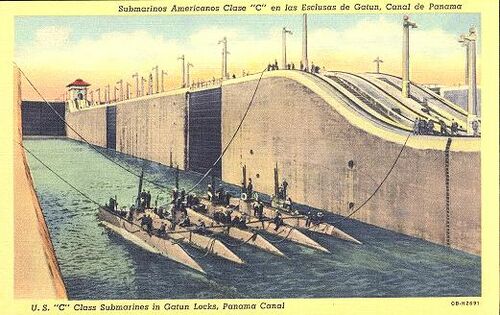
A post card that shows a picture taken shortly after the one on the previous page (March 9, 1914), but this time taken from atop the closed Gatun Lock gate. Pumping down of the lock has started and the boats are noticeably lower than before. The lock was to be used as a makeshift drydock. Since the canal was not yet fully open, this could be allowed. After the opening of the canal, an operation like this would not be allowed since it would effectively close the canal.
Photo in the private collection of Ric Hedman.
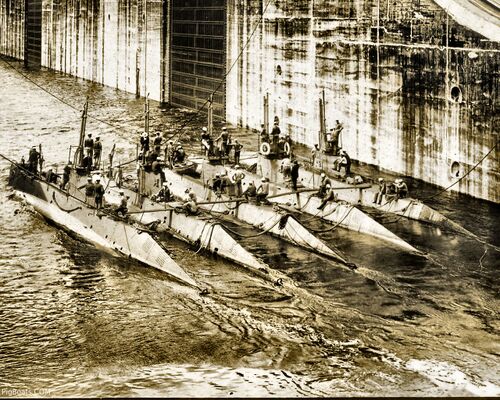
The Submarines are left to right the C-4, C-5, C-2, C-3 and C-1. The Submarine Division designator numbers are on their conning tower fairwaters as a "1" over another number, (this indicating their physical position in a division at-sea steaming formation). The C-1 is 1 over 3; the C-3 is 1 over 5; the C-2 is 1 over 1 (flagship); C-5 is 1 over 4, and the C-4 is 1 over 2.
Seen on the conning tower of the C-5 (second from left) in the white broad brimmed hat is probably the civilian pilot, whose responsibility it was to guide the submarines through the canal. The is still done to this day.
National Archives photo.

All five of the C-class submarines stationed at Panama are seen entering the East High Chamber of the Gatun Locks of the Panama Canal. There were no other dry docking arrangements to be had in Panama at this time.
The Gatun Locks raised vessels a total of 85 feet to the level of the Gatun Lake in three separate "chambers", the Low, Middle and High Chambers. Each chamber had several lock doors that only allowed the needed size of the lock to be raised or lowered rather than taking the time to fill or empty the whole lock.
The time frame for these photos is circa March/April 1914. This photo was used in an April 2, 1914 issue of the Christian Science Monitor newspaper story about the event. The submarines were rafted together and towed by hand, by the combined crews, into the lock and as interior lock doors were passed they were closed until the submarines were in the smallest portion, 400 feet long. No Lock traffic was impeded as the locks had not officially opened for business. The locks officially opened in July 1914.
Photo in the collection of MMCM(SS) Rick Larson, USN (Ret.)

As the lock emptied, the rafted boats sat down on wooden cradles that had been pre-placed in the lock chamber. This view shows nearly all of the water out of the chamber and the boats sitting on their cradles and braced to the side walls. Note that the handwritten notation on the photo is in error as to the location of the event.
Photo in the collection of MMCM(SS) Rick Larson, USN (Ret.)
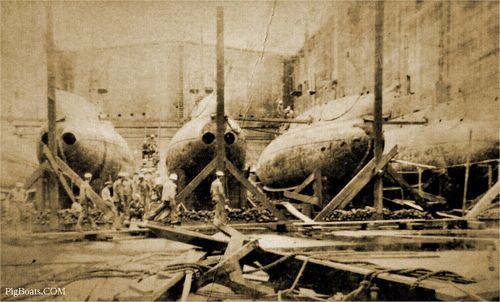
A view from the lock floor with sailors milling about conducting work. The two boats on the left have their bow caps rotated so that the two torpedo tubes are open. Only four of the boats are visible, C-1 is off to the left and out of view. For the remainder (left to right) are the C-2, C-3, C-5, and C-4.
Photo in the collection of MMCM(SS) Rick Larson, USN (Ret.)
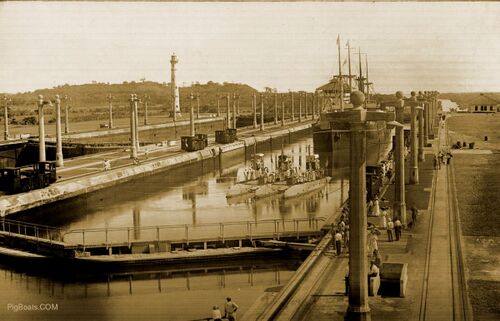
This photo shows three C-class submarines in the third or inner lock of the three Gatun Locks. We know the location because of the presence of the tall thin lighthouse at the inner door between the second and third locks. This lighthouse still stands today and can be seen by all that pass through the canal. This view then means that the vessels are traveling into the canal and Gatun Lake.
Everything looks very new. The locks were officially opened on August 25, 1914 and the five C-boats were officially sent to Panama to scout Panamanian ports and harbors for suitability for U.S. submarines on December 7, 1913. They were redesignated First Division and escorted by four surface ships. Their destination was Cristobal, C.Z. on the Atlantic side of the canal.
The five C-class boats were accompanied by four surface ships, but the record fails to say what kinds of vessels these were. The four masted cargo ship in the rear could be part of the four. That would make this a very early passage through the canal.
It is entirely possible that these submarines may be some of the first vessels through the canal. They were at Cristobal for eight months prior to the "official" opening. They may well have made trial transits prior to the date open to the public.
There are about 100, more or less, people standing at the lock wall watching the little boats go through. A number of Navy men with their wives are present and I suspect civilian workers who are running or supervising the canal are there too. A number are on the other side of the lock.
Photo in the private collection of Ric Hedman.
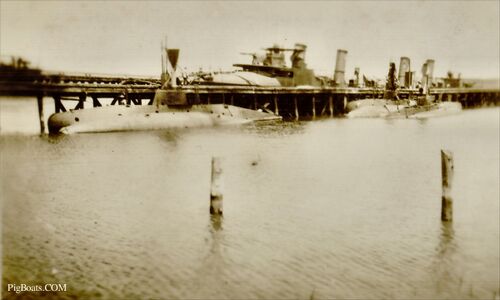
Three C-class submarines moored to a pier in what is likely Cristobal, Canal Zone, 1913-1917. Moored across the pier is a Hopkins-class destroyer.
Photo in the private collection of Ric Hedman.

The view is looking aft in the control room of an unidentified C-class submarine. The panel arrangement shows a higher level of refinement to the construction. The view shows the access ladder leading up from the starboard side and into the conning tower where the fixed periscope and helm were. Between the two panels is the open engine room. On the right side a large vise is attached to a small suspended work bench. Below that is the electric motor for the trim and bilge pump.
In the upper left of the photo what looks like a circular hatch is, what we believe to be, a mounting for a Fessenden Oscillator. This can be seen mounted in a similar photo on the C-1 page.
Photo in the private collection of Ric Hedman.
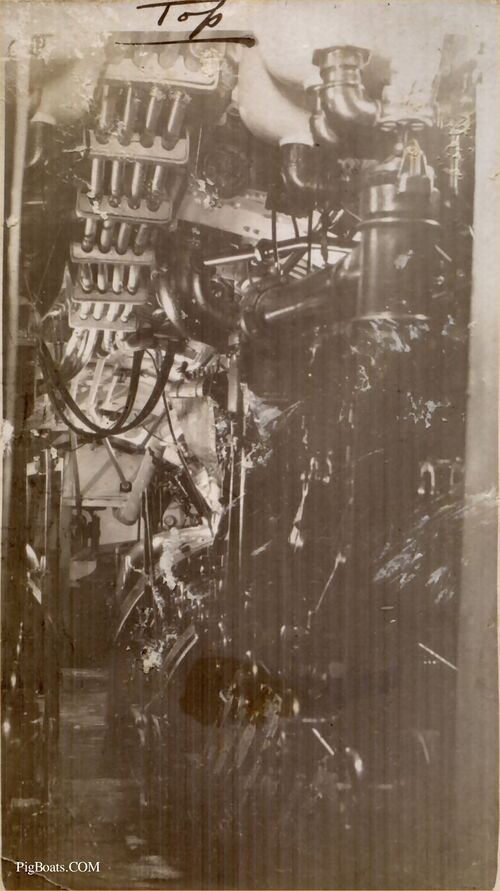
Interior view of a C-class submarine looking aft into the engine room. The photographer was standing just aft of the electrical control panel seen in the photo above. This is looking down the center line of the submarine with engines to each side. What is assumed to be large power cables are running in the overhead.
Original Photo in the Private Collection of Ric Hedman

October 30, 1912, New York City. The submarines C-5 and C-2 are moored to the west end of the 135th street pier on Manhattan Island. The submarine tender Severn, seen rear right, is moored to the same pier on the north side.
Crowds of people stand on the pier to get glimpses of these strange new underwater craft. In the background, (left), anchored in the Hudson River, is the New Jersey (Battleship No. 16) and, center is the Georgia (Battleship No. 15). This is probably the 1912 Presidential Review.
On the left hand submarine the name "Snapper" can be read rather easily on the life ring. On the right hand submarine the beginnings of the name "Stingray" can be seen on the life ring. This is an anachronism because the boats had been officially renamed C-5 and C-2 on November 17, 1911. The fact that the life rings still retained the original names is unusual.
Library of Congress photo, Bain Collection.
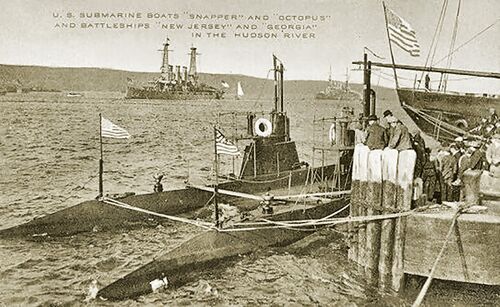
This photo was taken a little bit after the one above. Some work had been conducted on the C-2's aft deck. Lines have been moved around. Note the Allied Signal Bells on the aft deck of both boats. Disregard what is typed on the photo, the photographer was obviously unaware that the two boats had been renamed.
Photo in the collection of MMCM(SS) Rick Larson, USN (Ret.)
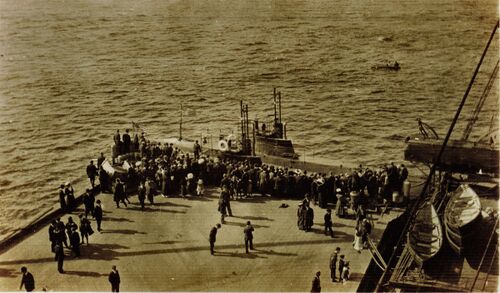
Another view of the C-5 and C-2. This was possibly taken several days before or after the previous photos. The photographer for this photo has climbed the foremast rigging on the tender Severn. Perhaps he was a crew member assigned to the Severn.
The 3 over 2 seen on the C-5's conning tower fairwater correspond to other known photos. The numbers refer to Submarine Division 3 and the lower number to the vessels place with in the Division. The inboard submarine displays a Division 3 number but the lower number can not be seen.
The boats have drawn quite a crowd on this day. In 1912 very few people had ever seen a submarine. The technology was new and futuristic and the presence of boats in any port always drew throngs of interested people.
Photo in the private collection of Ric Hedman.

A crew portrait of an unknown C-class boat, circa 1910-1912. The C-class had a crew complement of 15, and 15 men are topside. This is the whole crew.
Photo in the private collection of Ric Hedman.

USS Severn with an unidentified C-class submarine alongside. The location is unknown but suspected to be Panama circa 1914. Built in 1898-1900 as a sheathed, wooden hull bark with auxiliary steam power, Severn was never officially rated as a submarine tender. She was pressed into the role because as a cruiser she was already obsolete when commissioned, a product of a bygone era.
Photo in the private collection of Ric Hedman.
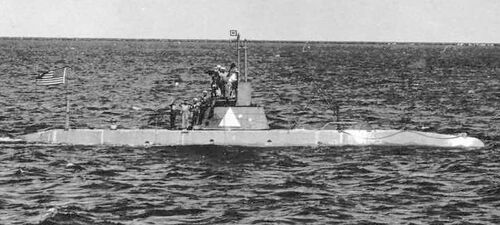
An unidentified C-class boat, location and date unknown. The meaning of the white triangle on the fairwater is also a mystery. Geometric shapes were used much later on the R-class boats as a visual identification expedient, but the exact purpose of this triangle is not known. Note the small "fish" flag affixed to the top of the #2 periscope. This is meant to alert any boater who may come upon to sticks floating vertical in the water that there is a submarine below.
Photo in the private collection of Ric Hedman.
Photos in the private collection of Ric Hedman.
Page created by:
Ric Hedman & David Johnston
1999 - 2023 - PigBoats.COM©
Mountlake Terrace, WA, Norfolk, VA
webmaster at pigboats dot com


